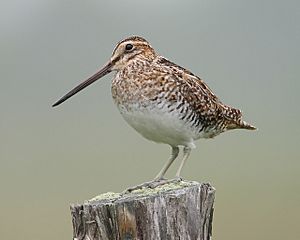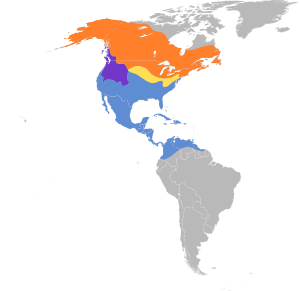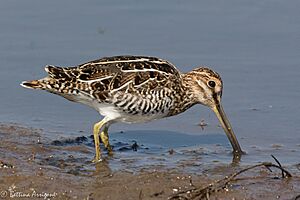Wilson's snipe facts for kids
Quick facts for kids Wilson's snipe |
|
|---|---|
 |
|
| Conservation status | |
| Scientific classification | |
 |
|
| Synonyms | |
|
Gallinago gallinago delicata Ord, 1825 |
The Wilson's snipe (Gallinago delicata) is a small, plump shorebird. These birds are known for their long, thin bills. The name gallinago comes from Latin words meaning "hen" and "resembling." This means the name describes a bird that looks like a hen. The word delicata is Latin for "dainty."
For a long time, the Wilson's snipe was thought to be a type of common snipe. But in 2003, scientists decided it was its own separate species. The Wilson's snipe has a thinner white edge on its wings. It also has eight pairs of tail feathers, while the common snipe usually has seven. This bird is named after Alexander Wilson, an American bird expert.
Contents
What They Look Like
Adult Wilson's snipes are about 23 to 28 centimeters (9 to 11 inches) long. Their wings can spread out 39 to 45 centimeters (15 to 18 inches) wide. They usually weigh between 79 and 146 grams (2.8 to 5.2 ounces).
They have short, greenish-grey legs and a very long, straight, dark bill. Their bodies are mottled brown on top, which helps them blend in. Their undersides are pale. They have a dark stripe across their eyes, with lighter stripes above and below it. Their wings are pointed, which helps them fly fast.
Habitat and Behavior
Wilson's snipes build their nests in wet areas. These include marshes, bogs, tundra, and wet meadows. They live in Canada, the northern United States, and the Chukchi Peninsula in Russia. Some snipes live all year on the Pacific coast of the U.S.
Other groups of snipes migrate south for the winter. They fly to the southern United States, the Caribbean, and northern South America. Scientists think that climate change might be causing these birds to arrive at their breeding areas earlier. They might also leave later than they did 100 years ago. For example, in Ohio, snipes used to arrive in late April. Now, many are already there by that time.
These birds look for food in soft mud. They use their long bills to probe for insects and earthworms. They also eat plant material. Wilson's snipes are very good at hiding because their feathers blend in with their surroundings. They are usually shy and stay close to plants on the ground. They only fly away when someone gets very close. When they fly off, they move in zig-zags. This helps to confuse any animals trying to catch them.
Reproduction and Sounds
During courtship, the male snipe performs a special "winnowing" display. He flies high in circles and then dives down. This creates a distinctive sound with his tail feathers. This sound is sometimes heard throughout the day and even at night. It sounds a bit like the call of a boreal owl. Wilson's snipes build their nests in well-hidden spots on the ground.
Population Status
Near the end of the 1800s, the number of Wilson's snipes went down. This was due to hunting and the destruction of their habitat. However, these birds are still quite common today. The IUCN does not consider them to be in danger. But, if large wetland areas are drained, local groups of snipes can be affected.
See also
 In Spanish: Becasina para niños
In Spanish: Becasina para niños



